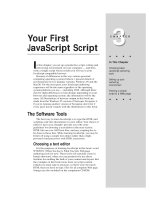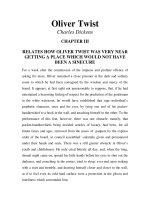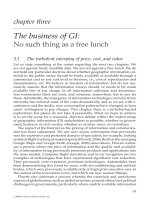Hedges on Hedge Funds Chapter 3 doc
Bạn đang xem bản rút gọn của tài liệu. Xem và tải ngay bản đầy đủ của tài liệu tại đây (134.82 KB, 10 trang )
CHAPTER
3
CHAPTER 3
The Operational Risk Crisis
A
s the hedge fund industry has grown explosively, so too has the list of
fund failures and burned investors, many of whom did not have
advance knowledge of potential warning signs. It seems as if we are con-
stantly faced with news reports about catastrophic losses incurred by
some of the industry’s best-known managers, and even those investors
who insist on a comprehensive due diligence process are not immune. To
better understand why hedge funds fail and how these failures could be
avoided, Capco conducted a recent study to assess why failures occur in
the hedge fund industry.
The findings of the study are compelling. The main area of concern is
that operational issues account for 50 percent of hedge fund failures, an
alarmingly high percentage. With that in mind, the key point of interest
to hedge fund investors is that they must expand their due diligence and
monitoring practices to ensure that they understand the back-office
capabilities of the hedge funds with which they are contemplating an
investment. This understanding can make a big difference in preventing
or avoiding a bad investment decision.
As background, it should be noted that this study is based on a data-
base of hedge fund failures that dates back 20 years and captures details
of losses, litigation, and root causes. Failed funds are considered those
that had been forced to cease investment operations suddenly and where
investors faced a significant or total loss of capital. This differs from a
43
*Stuart Feffer, PhD, and Christopher Kundro
c03_hedges.qxd 8/26/04 2:46 PM Page 43
more common discretionary fund closure, where a manager chooses to
unwind a fund over time and in an orderly manner. The findings are
based on over 100 failed funds over this period. The primary cause of
each fund’s failure attributed to at least one of these factors represent-
ing three basic categories of risk:
1. Investment Risk. These risks are market and related risks associated
with the investment style of the fund or the securities it held.
2. Business Risk. These risks are associated with the management of the
fund company as a business that are not directly related to market
movements, such as failure to reach a base level of assets under
management or a change in management of the fund.
3. Operational Risk. These risks are associated with supporting the
operating environment of the fund. The operating environment
includes middle- and back-office functions such as trade processing,
accounting, administration, valuation, and reporting.
Investment risk is the type of risk that fund investors generally
intend to take in exchange for the promise of performance. Business risk
includes factors that stem from the possibility that the fund manager
simply will be unable to create a sustainable business. Operational
risks are all of the other types of risks that investors do not intend to
take as part of their investment strategy, namely the risk that an invest-
ment might be fraudulent, that the infrastructure might fail, or that
managers might misrepresent performance.
In circumstances where it is difficult to isolate the leading causes of
a fund’s failure to a single category, failure is attributable to a combina-
tion of multiple risks that span these categories.
To understand common operational due diligence practices employed
in the industry, informal interviews and discussions with hedge fund
managers and consultants were conducted. The conclusion is that an
alarmingly high proportion of hedge fund failures can be attributed
to operational issues. Indeed, 54 percent of failed funds had identifiable
operational issues and half of all failures could be attributed to opera-
tional risk alone.
44 HEDGES ON HEDGE FUNDS
c03_hedges.qxd 8/26/04 2:46 PM Page 44
The Operational Risk Crisis 45
The most common operational issues related to hedge fund losses
have been misrepresentation of fund investments, misappropriation of
investor funds, unauthorized trading, and inadequate resources. (See
Figure 3.1.)
Misrepresentation of investments is defined as the act of creating or
causing the generation of reports and valuations with false and mis-
leading information. This may be due to deliberate deception (e.g., to
hide poor investment performance) or to operational errors.
Misappropriation of funds/general fraud includes managers who
knowingly move money or assets out of the fund either for personal use
or as an outright theft. Unauthorized trading and style breaches cover
fund managers who make investments outside of the stated fund strat-
egy or change the fund’s investment style without investor approval.
This is also known as unmonitored style drift and is included as an oper-
ational risk factor because it exposes investors to unintended risks that
occasionally result in fund failure.
Inadequate resources for fund strategy(s) is problematic when tech-
nology, processes, or personnel are not able to properly handle operat-
ing volumes or the types of investments and activities in which the fund
engages. (See Figure 3.2.)
Funds with
Operational Issues
54%
46%
Operational
Risk Only
50%
6%
38%
6%
Distribution of Failed Funds
with Operational Issues
Funds without
Operational Issues
Distribution of Fund
Failures
Business Risk
Only
Multiple Risks
Investment
Risk Only
FIGURE 3.1 Operational Issues and Primary Causes of Fund Failure.
c03_hedges.qxd 8/26/04 2:46 PM Page 45
46 HEDGES ON HEDGE FUNDS
These problems contributed to substantial investor losses in hedge
funds that might have been prevented or avoided with a more compre-
hensive investor due diligence and monitoring approach. For example,
in the case of the recent failure of the Lipper convertible arbitrage funds,
we believe that had investors scrutinized and monitored the funds’ val-
uation practices closely, there is a good chance that they would have rec-
ognized the absence of separation of duties in the pricing of illiquid
securities and either avoided investing in these funds or insisted on
changes that might have prevented the problem.
Of funds that failed as the result of operational risk only, nearly half
had multiple operational issues. (See the sample cases in Table 3.1.)
The most frequent combination of operational issues was misappro-
priation of investor funds and misrepresentation of fund investments.
(See Figure 3.3.)
Misrepresentation of fund investments and activities is clearly a
major problem as seen by its prevalence among failed funds and its rela-
tionship to other issues and risks. Although most managers do not set out
to defraud investors from day 1, many clearly have done so. We have
found numerous occasions where on the back of poor investment per-
formance, managers “modified” the valuation of their funds and/or their
Breakdown of Operational Issues
Misrepresentation
of Investments
Misappropriation
of Funds
Inadequate Resources
Unauthorized
Trading
41%
30%
14%
6%
9%
Other
FIGURE 3.2 Distribution of Operational Issues Contributing to Opera-
tional Risk in Hedge Funds.
c03_hedges.qxd 8/26/04 2:46 PM Page 46
S
trategy:
Market Neutral
Total Estimated Loss/Redemption:
$700+
Million
Primary Operational Issue:
Unauthorized Trading
Highlights:
■
Fund marketed as a market-neutral fund.
■
Betting on drop in interest rates leveraged 10 to 1.
■
Lost 60% of value in 7 months.
Strategy:
Convertible Arbitrage and International
Total Estimted Loss: $
300+ Million
Primary Operational Issue:
Misrepresentation of
Investments
Highlights:
■
Hedge fund manager wrote down $315 million.
■
Attributed it to a conservative pricing of illiquid
securities.
■
Pricing was done without third-party verification.
Strategy:
Fixed Income Arbitrage
Total Estimated Loss/Redemption: $
500+
Million
Primary Operational Issue:
Inadequate Resources/
Infrastructure
Highlights:
■
Fund had a steady track record for many years.
■
Shifted to new trading/investment strategy.
■
Risk management system could not fully support
new security types.
■
Resulted in high volatility leading to losses and
drawdowns.
Strategy:
Long/Short Equity
Total Estimated Loss:
$40+ Million
Primary Operational Issue:
Misappropriation of
Funds/Fraud
Highlights:
■
Funds had initial minimal loss that was hidden.
■
Funds manager misrepresented performance.
■
Attracted additional investments and opened more
funds.
■
Management used fund assets for personal
expenses.
47
TABLE 3.1
Sample Cases
c03_hedges.qxd 8/26/04 2:46 PM Page 47
investment results to buy time until actual results improved. In some
cases, when results did not improve, the modifications often became more
and more aggressive, were eventually discovered, and required a write-
down of assets. In these cases, the sudden correction usually led to a
total collapse of the fund.
Although it may be impossible to foresee which managers will
attempt to defraud investors, it is critical that investors understand the
extent to which the opportunity exists to manipulate and misrepresent
fund investments, should managers feel the urge. Investors can deter-
mine this information through more complete scrutiny of a hedge fund’s
operations and technology capabilities and a detailed understanding
of the information flows between a fund and its supporting service
providers, which typically include prime brokers and administrators.
Knowing that a fund has in place tight controls over cash flows and seeks
third-party verification of a valuation to insure that it is current and
appropriate will not eliminate the risk of fraud, but it will go a long way
in limiting the manager’s opportunity to perpetrate fraud.
Relying solely on a fund’s administrators and auditors may not be
enough, however. For example, to hide substantial investment losses,
48 HEDGES ON HEDGE FUNDS
Breakdown of Fund Failures
by Operational Issue
Misappropriation
of Funds
Misrepresentation
of Investments
18%
Unauthorized
Trading
5%
Other
14%
Inadequate
Resources
7%
Investment
Risk Only
Business
Risk Only
Multiple
Risks
Distribution of Fund
Failures
Operational
Risk Only
50%
Combination
of Operational
Issues
49%
6%
6%
38%
7%
FIGURE 3.3 Breakdown of Fund Failures Attributed to Operational Risk
Only by Operational Issue.
c03_hedges.qxd 8/26/04 2:46 PM Page 48
the Manhattan Fund allegedly created fictitious account statements that
materially overstated the value of the fund. These statements were pro-
vided to investors, potential investors, as well as the fund’s administra-
tor and auditor for more than three years with neither the administrator
nor the auditor catching the problem. As Figure 3.4 shows, misrepre-
sentation is a critical issue.
OPERATIONAL DUE DILIGENCE: AN IMPORTANT PART
OF THE INVESTMENT PROCESS
Operational due diligence is an important part of the investment process.
Although it can help address some fundamental questions affecting invest-
ment decisions, it tends to be the least monitored of all risks related to
hedge funds. Properly executed, operational due diligence is a comple-
ment to the normal investment due diligence that institutional investors
and professional advisors undertake for their clients before recommend-
ing a fund for investment. This investment due diligence typically includes
background checks on all of the principal parties in the fund management
company as well as investigations of investment style, past performance,
trading practices, and other aspects of the investment process. The supple-
mental operational due diligence that we suggest, however, also focuses on:
The Operational Risk Crisis 49
Breakdown of Combined
Operational Issues
Misrepresentation of Investments
and Misappropriation of Funds
Unauthorized Trading and
Misappropriation of Funds
74%
9%
13%
4%
Unauthorized Trading and
Inadequate Resources
Unauthorized Trading and
Misrepresentation of Investments
FIGURE 3.4 Breakdown of Most Frequent Combinations of Operational Issues.
c03_hedges.qxd 8/26/04 2:46 PM Page 49
■ Transparency of underlying positions in the invested funds for use
in generating risk analysis and tracking potential style drift
■ Capacity, or selecting funds that have capacity to accept additional
subscriptions
■ Survivorship, or confidence that the underlying funds will continue
to operate to alleviate the need for reallocation of invested funds
■
Flow of funds to ensure the proper controls, processes, and infor-
mation links are in place to allow quick valuations and timely allo-
cation and investment of subscriptions
TRADITIONAL APPROACHES TO OPERATIONAL REVIEWS
Investors should add operational risk questions to their standard due
diligence request for information. Questions might include:
■ Is there an ancillary component of the overall investment due dili-
gence process?
■ Is asset allocation based on a generic view across multiple managers,
fund types, and strategies?
■ Is the fund’s team focused on specific functions?
■ Is the fund focused on specific aspects of the operating environment?
■ Is due diligence specifically focused internally on the organizational
structure?
■ Is qualitative due diligence only often reduced to a background
check and character assessment of fund managers?
Information about the efficiency, effectiveness, capacity, and control of
hedge funds is rarely assessed in sufficient detail to inform investment
decisions and identify appropriate mitigation opportunities. With that in
mind, here are five key characteristics of an effective operational due
diligence approach for hedge funds:
1. It provides a comprehensive view of the structure, quality, and
control of the people, operations, technology, and data supporting
the fund.
50 HEDGES ON HEDGE FUNDS
c03_hedges.qxd 8/26/04 2:46 PM Page 50
2. It covers internal processes, systems, and information flows.
3. It covers the processes, systems, information flows, and interfaces
provided by external parties such as prime brokers, administrators,
custodians, and so on.
4. It analyzes the unique requirements of each fund/strategy as they
can vary considerably depending on fund objectives and invest-
ment style.
5. Assessments are updated on a periodic and event-driven basis.
The hedge fund industry only gets more challenging from here. Every
indication is that it is expected to maintain its steep growth trajectory.
Investors should expect that the anticipated growth in hedge fund
investing will be accompanied by increased performance and opera-
tional demands as the number of new managers grows, the breadth and
complexity of investment strategies expands, and new forms of regula-
tion are considered and eventually adopted.
All of this suggests that the operational risks associated with these
investments will only grow more important. For the hedge fund investor,
effective operational due diligence and monitoring will be key to reduc-
ing the potential of catastrophic losses and improving long-term invest-
ment results in this sector.
The Operational Risk Crisis 51
TIPS
Hedge fund blow-ups and stories of burned investors remain all
too common in spite of increased discussion of expert due dili-
gence and transparency. To examine the root causes of hedge fund
failures, Capco recently studied more than 100 hedge funds and
20 years’ worth of data to evaluate hedge fund losses and litiga-
tion. The study’s key finding is that operational issues account for
more than 50 percent of these failures, which indicates the need
for careful study of a hedge fund’s back office prior to making an
investment.
c03_hedges.qxd 8/26/04 2:46 PM Page 51
52 HEDGES ON HEDGE FUNDS
■ Before investing, be sure to understand the hedge fund’s poten-
tial for investment risk (the investment style of the fund or its
securities), business risk (risks related to the sustainability of
the business), and operational risk (middle- and back-office
functions).
■ Ask the hedge fund manager about style drift (changing the
fund’s investment style without investor approval). When
style drift is unmonitored, it may expose investors to unin-
tended risks.
■ Determine if the fund’s technology and personnel are well
equipped to handle the proper level of operating volumes or
types of investments in which the fund engages.
■ Monitor the possibility of misrepresentation of investments,
which occurs when a hedge fund manager provides false or
misleading information, often to hide poor investment per-
formance or errors.
■ Watch out for misappropriation of funds and fraud, which
may happen if a hedge fund manager knowingly moves assets
out of the fund for personal use or as theft.
■ Scrutinize and monitor fund valuation practices through
ongoing due diligence.
■ Check on the hedge fund’s underlying positions to generate
risk analysis and track potential style drift.
■ Evaluate survivorship and gain confidence that the underlying
funds will continue to operate to alleviate the need for reallo-
cation of invested funds.
■ Be sure that the proper controls are in place to allow quick val-
uations and timely allocation and investment of subscriptions.
c03_hedges.qxd 8/26/04 2:46 PM Page 52









